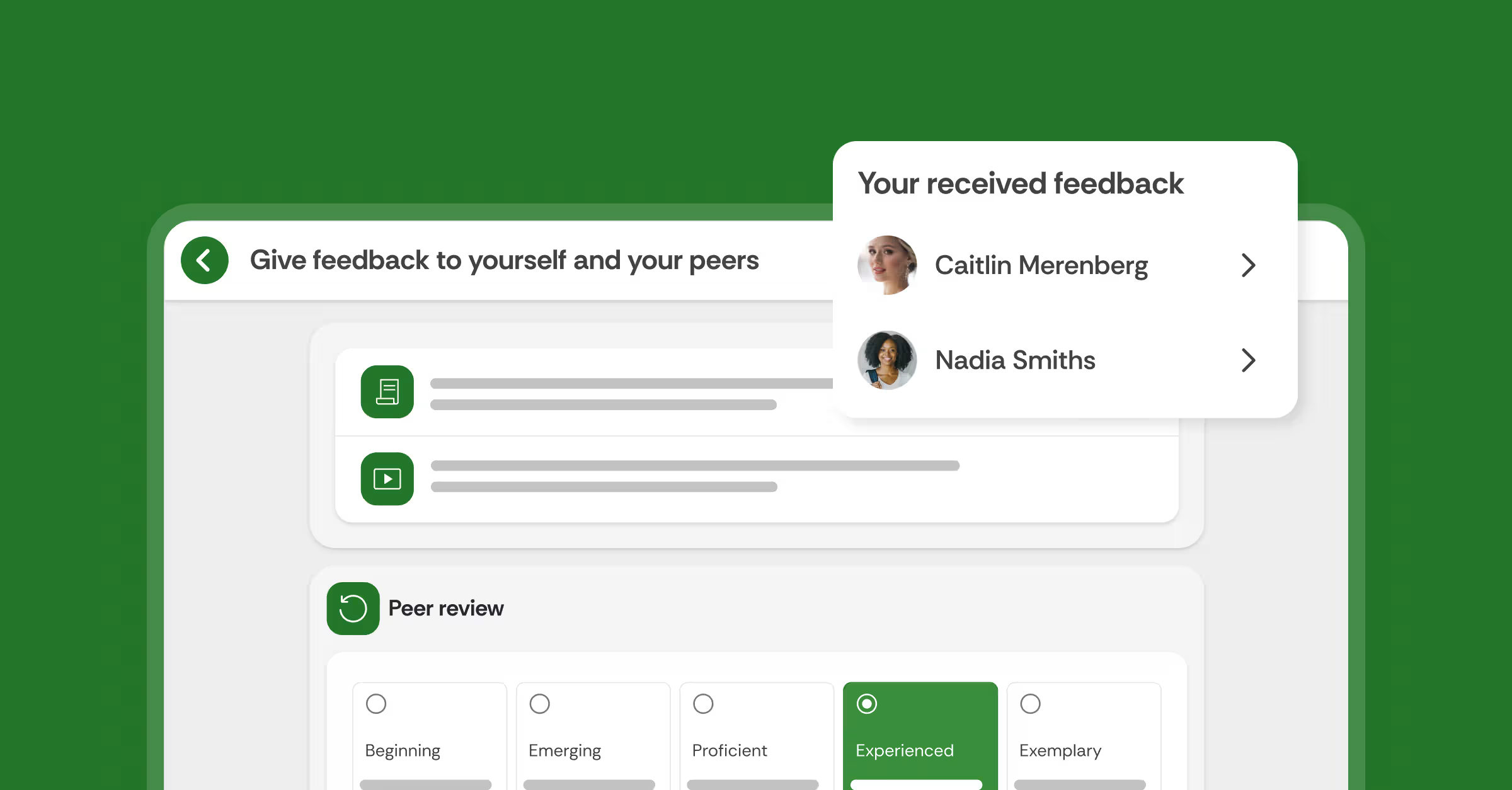Save time and maximize faculty success with FeedbackFruits templates
Quality curriculum planning is key to enhancing student learning experience and success. But how can institutions achieve this while there is too much to be checked on the to-do list? Teaching templates emerge as the game-changing method to help faculties reduce workload, save time, and achieve better outcomes.
In this blog, we explore the benefits and how institutions can minimize faculties’ workload and maximize positive results by utilizing FeedbackFruits Templates. To go further, you can also explore our Workload Reduction Bundle, try the ROI Calculator, or browse the Template Library in the Learning Design Community.
Create and scale templates in FeedbackFruits libraries
Lisa Fink, a passionate Curriculum Developer and Author of the Thinktank blog emphasized the great advantage of using teaching templates:
Using a template allows teachers to ditch the textbook, save time and reduce stress, as it eliminates the need to start from scratch when creating a lesson plan.
Understanding the many benefits that templates can bring, FeedbackFruits introduces the Libraries feature, allowing educators to create, save, and then scale templates of learning activities, rubrics, and learning journeys and, at the same time, share, discover, and reuse templates created by others.
These templates are accessible via the FeedbackFruits Libraries and the Learning Design Community, a collaborative space where educators can share and adopt best practices.
Read more about FeedbackFruits Learning Design Community.
What can you do with FeedbackFruits Libraries:
- Create standardized template libraries: Generate activity, rubric, and learning journey templates and save them as individual or institutional libraries.
Read more about learning journeys.

- Easily customize and scale the templates: Copy and adapt templates to suit specific course requirements and students’ needs.
- Share templates with colleagues: Share your templates with colleagues, your department, or across institutions with just one click.

- Share and discover tried-and-tested templates: Explore evidence-based templates created and contributed by educators worldwide via the Learning Design Community.
By leveraging FeedbackFruits Libraries, educators can streamline their course design processes, ensuring they deliver high-quality education without the extensive time commitment typically required.
Read more about the feature in our Help Center.
The benefits of using templates in teaching
Developing and utilizing templates presents a multitude of benefits.
1. Time efficiency
Creating a comprehensive course or a detailed activity from scratch can be incredibly time-consuming. Templates provide a ready-made structure that educators can quickly adapt, saving valuable time that can be redirected to other critical teaching tasks.
Curious how much time and costs you can save? Try our ROI Calculator.
2. Consistency and quality
Templates ensure that courses and activities adhere to high-quality standards. By using tried-and-tested templates, educators can maintain a consistent level of quality across different courses and learning activities, enhancing the overall learning experience for students.
3. Scalability and customizability
Templates make it easier to scale educational programs. Whether teaching a small class or a large cohort, educators can efficiently replicate successful teaching strategies and activities across multiple sections or courses.
Despite their structured nature, templates are highly customizable. Educators can modify them to fit their specific teaching styles, course objectives, and student needs, ensuring a personalized learning experience.
5. Collaboration and sharing
The collaborative aspect of templates, especially within the FeedbackFruits Learning Design Community, allows educators to share their successful templates with peers. Not only does this foster a community of practice but it also encourages the continuous improvement of teaching strategies.
6. Personalize learning and inclusive teaching
With templates, instructors can easily create personalized learning activities that address students’ diverse needs while ensuring all the lesson’s elements are covered. By spending less time on lesson development, instructors can focus more on supporting students. Templates also make it easier to integrate culturally responsive teaching, ensuring inclusivity and equity are embedded in course design.
For institutions looking to cut down repetitive tasks at scale, the Workload Reduction Bundle includes 7 learning activities that save 30+ hours per course while enhancing collaboration and feedback.
8 Best tips to use FeedbackFruits templates to maximize faculty success
1. Pay attention to naming
Make sure to give each of your templates a unique name so you and your colleagues can easily recognize it.

2. Add notes to templates
With FeedbackFruits Libraries, you can easily add notes in the form of text or video to inform your colleagues of what the goal of the activity is and how they can customize it.

3. Keep it simple and straightforward
Avoid adding too many components to a template (whether it is a rubric, learning activity, or learning journey), as this can make it difficult to manage, reuse, and take more time to plan.
You can find rubrics, learning activity and learning journeys in our Learning Design Community Page. Use the search bar on the left to select the template type that you're looking for.

4. Organize templates into shared libraries
Save your successful lesson plans as an individual My Library, as a Shared Library to share across your department, or as an Institution Library for use across the entire institution.

5. Utilize a variety of activity and rubric templates
You can diversify the types of templates you use. Integrate different learning activities and rubrics within a learning journey, or combine different learning journeys to create a rich and varied educational experience that stimulates skills development and lifelong learning. This variety will keep students engaged and cater to diverse learning styles.
6. Encourage student feedback
Incorporate feedback loops within your templates to continuously improve the learning experience. Use our Feedback and Assessment Solutions to incorporate multi-layer feedback (self, peer, group feedback) to generate insights from students and make necessary adjustments. Adding a self-reflection step at the end of the activity for students to critically evaluate their performance is also an effective way to collect students’ feedback.
Learn more about the learning activities included in the Feedback & Assessment solution.
7. Assess and reflect
Regularly assess the effectiveness of the templates you use. Reflect on what worked well and what could be improved. This ongoing evaluation will help you refine your approach and ensure that your teaching methods continue to evolve and improve.
8. Train and support your team
Every faculty member needs to receive sufficient support to utilize templates effectively. Provide support and resources to help your colleagues integrate templates into their teaching practices smoothly. FeedbackFruits works closely with institutions to provide instant support via workshops, training videos, help articles, and more.
9. Leverage community of practices
The world of education is constantly evolving, and new teaching strategies and tools are continually being developed. FeedbackFruits Learning Design Community is where you can find innovative, evidence-based templates created and shared by the FeedbackFruits Pedagogy Team and our partner institutions worldwide.
Engage actively with the FeedbackFruits Learning Design Community. Explore the shared templates, participate in discussions, and collaborate with other educators. This community is a rich resource for innovative teaching ideas and best practices.
Scaling best practices in education with templates
Templates have proven to be an invaluable resource for higher education faculties seeking to save time and enhance the quality of their teaching.
By offering customizable, high-quality templates that can be easily adapted and shared, FeedbackFruits empowers educators to create consistent and engaging learning experiences without the required extensive time commitment. By integrating these templates into your teaching strategies, faculties can significantly reduce workload, enhance student engagement, and achieve better educational outcomes.
Take the next step:
- Explore the Workload Reduction Bundle for ready-made activities that reduce workload.
- Use the ROI Calculator to measure time and cost savings at your institution.
- Browse the Template Library in the Learning Design Community to discover and share templates created by educators worldwide.
- Schedule a meeting with our team members, we're here to guide you and find the best solutions for your educational goals.
- Read more about the feature in our Help Center.
By integrating these templates into your teaching strategies, faculties can significantly reduce workload, enhance student engagement, and achieve better educational outcomes.
















![[New] Competency-Based Assessment](https://no-cache.hubspot.com/cta/default/3782716/interactive-146849337207.png)










